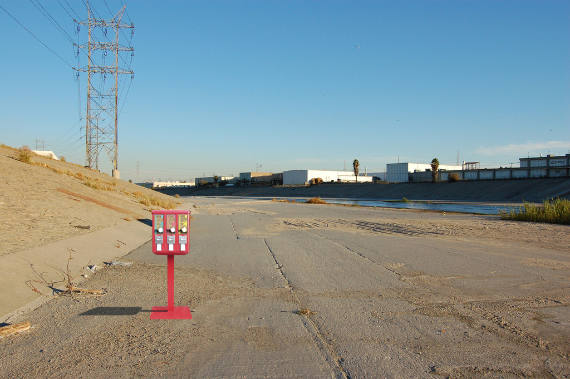 [Greenaid dispersal machine, image via Fletcher Studio]
[Greenaid dispersal machine, image via Fletcher Studio]
While cartoonish depictions of ol' Johnny Appleseed aren't particularlly accurate (he was more real estate mogul and bootlegger then selfless seed(plant not human) spreader) the notion of unruly citizen powered rewilding through guerilla seed dispersal is a fun thought.
Local Ecologist pointed us to the collaborated efforts of Fletcher Studio and Common Studio to create 'Greenaid', a gumball machine type seed bomb dispenser and:
They can be thrown anonymously into these derelict urban sites to temporarily reclaim and transform them into places worth looking at and caring for. The Greenaid dispensary simply makes these guerilla gardening efforts more accessible to all by appropriating the existing distribution system of the quarter operated candy machine.
Its this paragraph taken from Common's site that bothered me a bit, and let me preface with I like the idea, but playing devil's advocate. The pre-made seed bombs takes all the mystery and power away from the Guerilla Gardener. I no longer envision garden militants in dungy basements, crafting their own specific mixes and divising planned attacks for specified locations. The seed material has already been decided and contained through these machines dispersed through out cities. The bombing effort is thus less guerilla and more modern warfare gardening with, in this case, David Fletcher the Commanding General of potentially hundreds of seed dispersing infantry. This type of garden warfare is in contrast to the landscape architect manned drone guerilla gardening warfare we discussed previously.
 [Greenaid packaging and product, image via Fletcher studio]
[Greenaid packaging and product, image via Fletcher studio]
The other comment that troubled me about this approach is "reclaim and transform them into places worth looking at and caring for." This points to one of the many complications with Guerilla Gardening, that it is very subjective to consider what areas are "worth looking at." To some, an abandoned parking lot holds special value, local kids use it for baseball, kickball, etc., then some asshole comes by and plants trees and grasses everywhere, shifting the value, creating it for some, while destroying it for others.
Regardless, if I were to walk by one of these machines and had a quarter on me, I'd definitely buy a Greenaid and chuck it in an odd place. And I think that is the beauty of the idea, accessibility, just keep them out of my sandlot.
In a slightly unrelated topic, Common Studio also has another modular urban remediation project on their site worth checking out titled '[C]Urban Ecology', from their site:
(C)urban Ecology is a modular micro-remediation infrastructure that integrates seamlessly within our existing streets, supplanting the mundane utilitarian curb-and-gutter system to offer new levels of amenity. A versatile and performative design provides opportunities for water permeation and street vegetation, while sequestering small scale debris before it reaches the urban watershed.
Identifying the typical urban street as both the source of the problem as well as the site of the solution, (C)urban Ecology targets the issues of polluted urban drainage at the most feasible scale of intervention, and achieves maximum positive impact on the built and natural environment with minimal material and energy inputs.
Because it can be deployed and aggregated at various intensities, (C)urban Ecology can be effective from the scale of a single unit installed near a storm drain, to an array of 100 units that fringe the sidewalks of an entire city block.
Related: Ludic Guerrilla Gardening Drone Warfare | Genetic Necessities of Wilderness
